 |
The U.S. Bureau of Mines (Bureau), evaluated the effects of two iron-based fuel additives on diesel particulate matter (DPM) emissions. The 5.6-L, 6-cylinder test engine is typical of types used in underground mines. One additive, ferrous picrate, lacked measureable effects on exhaust emissions. The report is mainly about a ferrocene-based additive that reduced DPM between 4 and 45 pct, depending on engine operating conditions. The report concludes that the DPM reductions were caused by the catalytic oxidation properties of a ferric oxide coating developed inside the engine's combustion chamber. The ferric oxide coating also decreased gas-phase hydrocarbons and O2, but increased CO2 and NOX. The increased NOX, of about 12 pct, is considered the only adverse effect of the ferrocene-based fuel additive. The results suggest that the effectiveness of ferrocene was partially offset by increased sulfates because of the high-sulfur fuel used. Recommendations for continuing fuel additive research are presented.
| Author(s): | Zeller-HW, Westphal-TE |
| Reference: | U.S. Department of the Interior, Bureau of Mines, Report of Investigations 9438, 1992:1-26 |
ri9438 (PDF, 1756 KB)